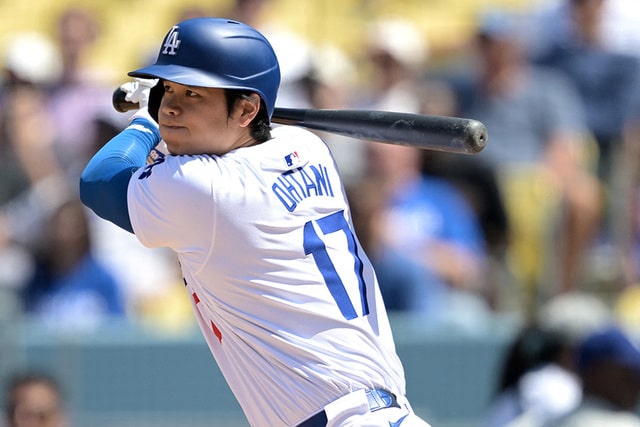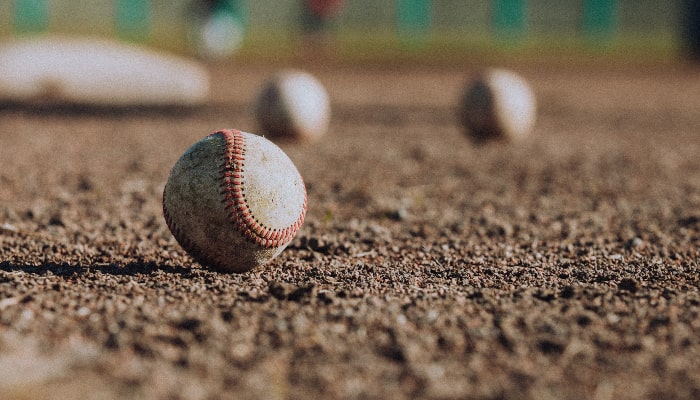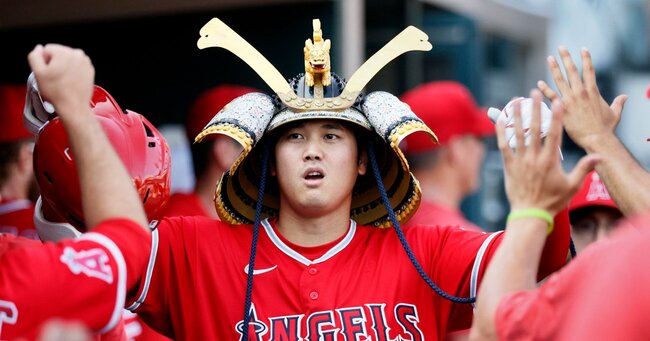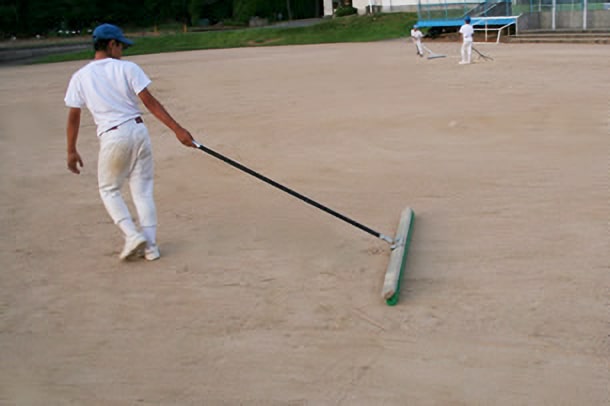
Maintenance of baseball fields is an important task that directly impacts the quality of the game and the safety of players.
Proper maintenance provides an environment in which players can perform at their best and spectators can enjoy high-quality matches.
This article will explain in detail the specific grounds maintenance procedures and key points.
From routine maintenance to major off-season overhauls, we cover all the ways to keep your grounds in top condition.
目次
Basics of Grounds Maintenance
Maintenance of baseball fields is an important task that directly impacts the quality of the game and the safety of the players.
Proper maintenance provides an environment in which players can perform at their best and spectators can enjoy high-quality matches.
Here we will explain in detail the importance of grounds maintenance and the basic steps.
The Importance of Grounds Maintenance
Grounds maintenance serves the following important functions:
1. Ensuring player safety: On poorly maintained grounds, players are at greater risk of slipping or tripping. In particular, proper maintenance of the infield soil, pitcher’s mound, and batter’s box is essential to ensuring player safety.
2. More fair play: A uniform ground surface allows for a more consistent bounce of the ball and more predictable defense and batting, making the game fairer and providing a level playing field.
3. Smoother game progress: Proper maintenance reduces the number of problems during the game. By smoothly draining water after rain and carrying out small maintenance work during the game, the game can proceed smoothly.
4. Improved spectator satisfaction: A well-maintained ground is also attractive to spectators. A neatly maintained field looks good and improves the comfort of spectators. Also, a match with fewer problems means less stress for spectators and higher satisfaction.
Basic Grounds Maintenance Procedures
Grounds maintenance involves both daily tasks and work to be done before and after games.
Here are the basic steps:
1. Trash Removal: After each game or practice, remove any trash from the entire field. This includes plastic bottles, food wrappers, and other trash. Removing trash will allow for the next step.
2. Draw the Lines: Use chalk or paint to accurately draw the lines for the baseline, batter’s box, and catcher’s box. Accuracy is important because unclear lines can affect the call of the play.
3. Infield soil maintenance: The infield soil is prepared evenly using rakes and brushes. Areas that are frequently played on and around the bases are especially well maintained. Water as needed to maintain the soil in good condition.
4. Pitcher’s Mound and Batter’s Box Maintenance: The pitcher’s mound will be regularly topped off with soil to maintain its height and slope, and the batter’s box will be topped off with soil and maintained to keep the surface smooth.
5. Outfield Grass Maintenance: The outfield grass will be regularly mowed to maintain the appropriate height. This will allow the ball to roll smoothly and reduce the risk of players slipping. In addition, watering and fertilizing will be done to keep the grass healthy.
6. Drainage Maintenance: After rain, check the drainage of the ground and carry out drainage work if necessary. In particular, we will focus on low-lying areas of the infield and around the bases, as these are prone to puddles.
7. Fence and dugout inspections: Fences and dugouts will also be inspected regularly and repaired or cleaned to ensure the safety and comfort of players and spectators.
Proper grounds maintenance is extremely important to the game of baseball.
Regular maintenance will help provide a safe and fair playing environment and increase satisfaction for players and spectators.
Follow these basic steps to ensure you always look your best.

How to prepare the infield
Infield maintenance is crucial to ensuring the quality of the game and the safety of the players.
Proper maintenance will ensure smooth infield play and provide an environment in which players can perform at their best.
Here we will explain in detail about infield soil management and maintenance around the bases.
Infield soil management
Infield dirt is an important factor that directly affects the progress of the game and the movements of the players.
Poor soil management can cause the ball to bounce erratically and players to slip, resulting in injuries.
1. Uniform soil: It is important to make the infield soil uniform using a rake or brush. Especially after games and practices, focus on areas where the play is concentrated (pitcher’s mound, batter’s box, around the bases). Uneven soil makes it difficult to predict the bounce of the ball, which affects defensive performance.
2. Humidity control: It is important to keep the soil at a moderate level of humidity. If it is too dry, dust will easily form, and if it is too wet, it will become slippery. To maintain a moderate level of humidity, water the soil before games and practice sessions to keep it moderately moist. Regular watering is especially important in the summer and other dry seasons.
3. Replenishing the soil: The soil on the infield needs to be replenished regularly. In particular, the pitcher’s mound, batter’s box, and areas around the bases are frequently used, so the soil is easily worn down. Replenishing these areas with new soil and compacting it firmly will enable stable play.
4. Compaction: The infield soil maintains its stability by being properly compacted. Using heavy machinery or rollers to firmly pack the soil gives players more stability underfoot and reduces the risk of injury. Proper compaction also improves drainage.
Maintenance around the base
The areas around the bases are areas where players frequently run, so special care is required.
Proper maintenance ensures fairness of play and the safety of players.
1. Base Securing: Bases must be securely secured. If the base moves, players are at increased risk of slipping or tripping and injuring themselves. Regularly check the stability of the base and re-secure it if necessary.
2. Preparation of the soil around the base: The soil around the base needs to be especially well prepared. Use a rake or brush to even out the soil evenly, to prevent irregular bouncing or instability underfoot during play. The soil is easily worn down by sliding and running, so it needs to be prepared frequently.
3. Ensuring a safe zone: Soft soil is used around the bases to ensure the safety of players. Especially around second and third base, where there is a lot of sliding, the soil is kept soft so that players can land safely. It is also important to provide adequate cushioning to prevent injuries when sliding.
4. Drawing Marks and Lines: It is also important to accurately draw the lines and marks around the bases so that players can stand in the correct positions and play is fair. Use chalk or paint to clearly redraw the baselines and batter’s box lines.
5. Regular inspection and maintenance: The base area will be inspected and maintained regularly before and after games and practice sessions. This will keep it in optimal condition and prevent any problems during the game. Inspection and maintenance will be especially focused after rain and during dry seasons.
Infield maintenance is essential to ensuring that baseball games are played safely and fairly.
By properly managing the soil and maintaining the area around the base, we can provide an environment where players can play with confidence and improve the quality of the game.
Be sure to perform regular maintenance and inspections to keep your equipment in optimal condition.
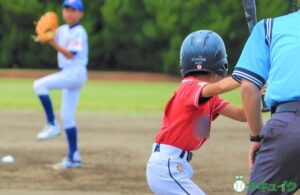
How to prepare the outfield
Outfield maintenance is crucial for players to perform at their best and spectators to enjoy the game.
Proper maintenance can provide a safe and comfortable playing environment and improve the quality of the match.
Here we will explain in detail about maintaining the outfield grass and the area around the outfield fence.
Outfield turf management
Outfield turf maintenance is essential to keeping the outfield playing area in optimal condition.
Maintaining healthy turf helps keep players’ feet more stable and reduces the risk of injury.
1. Regular mowing: Outfield grass should be mowed regularly to keep it at a uniform height. Ideally, mowing should be done once a week or before a game. Mowing to the correct height will help the ball roll more smoothly and the players have a more stable run.
2. Timing and amount of watering: Watering your lawn at the right time and in sufficient quantities is important to maintain its health. Regular watering is necessary, especially during dry seasons and periods of frequent matches. Installing an automatic watering system can provide an even supply of water and reduce the hassle.
3. Fertilize: Fertilize regularly to promote grass growth and keep it healthy. The type and amount of fertilizer should be adjusted according to the condition of the grass and the season. Proper fertilization will keep your grass strong and disease resistant.
4. Weed and Pest Management: Weeds, diseases and insects are major threats to the health of your turf. Regularly check your fields, apply herbicides and insecticides as needed, and respond quickly to any signs of disease and monitor the condition of your turf.
5. Aeration and aeration: Regularly aerate your lawn to provide oxygen to the grass roots and promote healthy growth. This loosens the soil so it can absorb water and nutrients more efficiently. Aeration is especially effective for dense grass or soil that has become compacted due to heavy machinery use.
Maintenance around the outfield fence
Maintenance around the outfield fence is important for player safety and maintaining the overall appearance of the field.
Proper maintenance will prevent problems around the fence and ensure the game proceeds smoothly.
1. Fence inspection and repair: The outfield fence should be inspected regularly to check for any damage or looseness. If any damage is found, repair it promptly to ensure the safety of the players. Also, check that the fence is securely fixed.
2. Replacement of cushioning: If cushioning is installed on the fence, check its condition regularly and replace it if it is worn out. The cushioning absorbs the impact when an athlete hits the fence, reducing the risk of injury.
3. Mowing the grass around the fence: Regularly mow the grass around the fence to ensure visibility. This allows players to play safely without losing sight of the fence. Also, regular mowing is necessary because overgrown grass can become a breeding ground for pests.
4. Maintaining the landscape: Regular cleaning is carried out to maintain the landscape around the fence. Removing trash and fallen leaves and keeping the fence clean and beautiful will give a good impression to spectators. A beautiful field will increase the satisfaction of players and spectators.
5. Rain measures: When it rains, we take measures to prevent puddles from forming around the fence. If necessary, we install drainage ditches to improve drainage. This will allow the field to remain in good condition even after a game is played after rain.
How the outfield is maintained is crucial to player safety and improving the quality of the game.
Proper maintenance of the turf and fence area provides the best playing environment and allows spectators to enjoy the game in peace.
Be sure to carry out regular inspections and maintenance to keep your equipment in optimal condition.

Pitcher’s mound and batter’s box maintenance
The pitcher’s mound and the batter’s box are particularly important areas in the game of baseball.
Proper maintenance can help maximize player performance and provide a safe and fair playing environment.
Here we will go into detail about pitcher’s mound maintenance and batter’s box service procedures.
Pitcher’s mound maintenance
The pitcher’s mound is the base area from which the pitcher can deliver accurate pitches.
Proper maintenance can help keep a pitcher’s feet more stable and reduce the risk of injury.
1. Maintaining Mound Height and Slope: The height of the pitcher’s mound is typically set about 10 inches (25.4 centimeters) above home plate. To maintain this height and slope, the soil should be periodically replenished and evenly trimmed. The slope should gradually decrease toward the front of the mound to provide a stable footing for the pitcher.
2. Maintain pitching areas: Areas that pitchers frequently step on are particularly susceptible to wear. Fill these areas with fresh soil and pack it down firmly with a rake or tamper. This is important to keep your footing from slipping after each pitch.
3. Soil humidity control: The soil on the pitcher’s mound needs to be kept at a moderate level of humidity. If it is too dry, dust will form, and if it is too wet, it will become slippery. By watering it regularly and maintaining a moderate level of humidity, the pitcher’s feet will be stable.
4. Use of maintenance tools: Specialized tools such as rakes, brushes, tampers, and rollers are used to maintain the pitcher’s mound. It is important to use these tools to evenly distribute the soil and compact it appropriately. Also, always check the condition of the mound before and after games and practices and perform any necessary maintenance.
5. Regular Inspection and Adjustment: Before and after games and practice, check the height and slope of the mound regularly and adjust as necessary. Particular inspection and maintenance should be done after rain or during dry seasons. This will ensure that the mound is always in optimal condition.
Batter’s box maintenance procedure
The batter’s box is a key area for a batter to feel comfortable and perform at his best.
Proper maintenance will help keep batters on their feet and provide a fair playing environment.
1. Draw the lines: Draw the batter’s box lines accurately for each game and practice. Use chalk or paint to draw the batter’s box lines centered on home plate. Accurate drawing of the lines is important for the batter to be in the proper position.
2. Replenishing and maintaining the soil: The soil in the batter’s box is easily worn down because the batter steps on it frequently. Replenish with new soil, smooth it evenly with a rake or tamper, and firmly pack it down. Pay particular attention to maintaining the area where the batter steps.
3. Humidity control: It is important to keep the soil in the batter’s box at a moderate humidity level. If it is too dry, dust will form, and if it is too wet, it will become slippery. Sprinkle water appropriately to keep the soil moist. This will give the batter a stable footing.
4. Check for firmness and cushioning: Check that the soil around the batter’s box is well-packed and that cushioning is used to keep players safe during sliding and aggressive play. Add more soil and re-pack if necessary.
5. Regular maintenance and checks: Before and after games and practices, check the condition of the batter’s box regularly and perform any necessary maintenance. Particular attention should be paid to checks and maintenance after rain or during dry seasons. This will ensure that the batter’s box is always in optimal condition.
The maintenance of the pitcher’s mound and batter’s box is essential to ensuring that baseball games are played safely and fairly.
Proper maintenance and repairs can provide an environment where players can play with peace of mind, improving the quality of the game.
Be sure to carry out regular inspections and maintenance to keep your equipment in optimal condition.
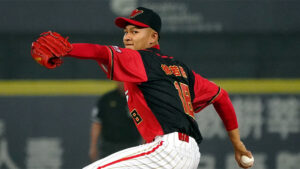
Daily maintenance and off-season management
The maintenance of a baseball field is divided into daily maintenance and large-scale maintenance during the off-season.
By carrying out these tasks properly, we can maintain the quality of the ground and provide an environment in which players can perform at their best.
Here we will explain in detail about daily ground maintenance and large-scale off-season maintenance.
Daily grounds maintenance
Routine maintenance is essential to keep the grounds in good condition.
By performing these tasks regularly, you can reduce the burden of maintenance required after each match or practice, and extend the life of the field.
1. Trash Removal: After each game and practice, the entire field will be cleared of trash. This includes plastic bottles, food wrappers, and other trash. Removing trash ensures smooth maintenance operations and player safety.
2. Draw the lines: Draw the baseline, batter’s box, and catcher’s box lines accurately. Unclear lines can affect the call of the play, so be precise. Use chalk or paint to draw the lines clearly.
3. Soil maintenance: The infield soil is prepared evenly using rakes and brushes. Particular care is taken in areas with a lot of play and around the bases. To maintain the soil condition, water it as needed. In addition, the soil on the pitcher’s mound and batter’s box is regularly replenished and compacted to provide stability for players’ feet.
4. Outfield Grass Maintenance: The outfield grass will be regularly mowed to maintain the appropriate height. This will allow the ball to roll smoothly and reduce the risk of players slipping. In addition, watering and fertilizing will be done to keep the grass healthy.
5. Drainage maintenance: After rain, check the drainage of the ground and carry out drainage work if necessary. In particular, focus on low areas of the infield and around the bases, where puddles tend to form. Clean the drainage ditches and take measures to improve drainage.
Large-scale off-season maintenance
Extensive off-season maintenance is necessary to improve the overall quality of the grounds.
These works will resolve any issues that routine maintenance cannot address and will refresh the grounds for next season.
1. Soil improvement: During the off-season, we work to improve the infield soil. We use soil conditioners to improve the soil’s drainage and water retention. We also improve the soil’s nutrient balance to promote plant growth. This ensures that the infield soil is always in optimal condition.
2. Grass Regeneration: The outfield grass is regenerated during the off-season. Grass seeds are planted and new grass is grown to prepare for the next season. Old and damaged grass is removed and new grass is planted to keep the grass uniform and healthy throughout the outfield.
3. Fence and dugout maintenance: During the off-season, we inspect and repair fences and dugouts. We check that fences are secure and re-secure them as necessary. We also paint dugouts and inspect equipment to provide a safe and comfortable environment.
4. Lighting Inspection: Lighting equipment will also be inspected and serviced during the off-season. Lights will be adjusted and bulbs replaced to ensure uniform lighting. Electrical wiring will also be inspected to ensure safety.
5. Facility Updates and Improvements: During the off-season, we will update and improve facilities throughout the grounds. We will introduce new maintenance equipment to streamline maintenance work. We will also install new facilities to improve the comfort of players and spectators, and improve the quality of the grounds.
6. Training and Education: We provide training and education for grounds maintenance staff to share the latest maintenance techniques and knowledge, so that all staff are highly skilled and the quality of the grounds is always maintained at a high level.
By properly performing routine maintenance and large-scale off-season repairs, we can maintain the quality of our baseball fields and provide an environment in which players can perform at their best.
Be sure to perform regular maintenance and inspections to keep your equipment in optimal condition.
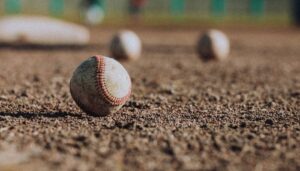
Tools and equipment required for grounds maintenance
Having the right tools and equipment is essential for maintaining a baseball field.
Using these tools allows for efficient and effective maintenance, providing the best possible fields for matches and practice.
This article provides detailed information on basic maintenance tools and how to use specialist equipment.
Basic maintenance tools
Basic maintenance tools are items that are frequently used in daily grounds maintenance.
These tools are easy to use and durable, and are important for making sure your maintenance work goes smoothly.
1. Rake: A rake is used to even out the infield dirt. It is good for pulling and spreading the dirt evenly, and it can make the surface of the dirt smooth. It is an essential tool, especially for areas with a lot of play and around the bases.
2. Brush: Brushes are used to sweep up fine dirt and sand from the infield and batter’s box. They are useful for smoothing out small areas that cannot be reached with a rake. They are especially used for final checks before drawing lines or before a game.
3. Watering hose: The watering hose is used to control the humidity of the ground soil. Maintaining the right amount of humidity prevents dust and makes the ground less slippery. Sufficient watering is especially important during dry seasons and before games.
4. Shovel: Shovels are used to dig up and replenish soil. They are especially useful for replenishing soil on pitcher’s mounds and batter’s boxes. They are also used to remove puddles after rainy weather.
5. Tamper: A tamper is a tool used to compact the soil. By compacting the soil on the infield, pitcher’s mound, and batter’s box, players’ feet are more stable and the risk of injury is reduced.
6. Chalk Liner: A chalk liner is a tool used to draw lines for baselines and the batter’s box. Accurate and clear lines are important to keep the game fair. The lines are drawn using chalk or paint.
How to use specialized equipment
Specialist equipment is used to increase the efficiency of grounds maintenance.
These machines can cover a wide area and provide highly accurate maintenance.
1. Ground roller: A ground roller is a large piece of equipment used to compact the soil evenly. By compacting the soil evenly across the infield, pitcher’s mound, and batter’s box, it increases stability underfoot during play. When using a ground roller, it is important to roll slowly and evenly.
2. Aerator: An aerator is a piece of equipment used to improve lawn aeration. By creating small holes in the grass, it allows oxygen, water and fertilizer to reach the roots more easily. This results in healthier grass and improved quality of play area. Regular use is effective.
3. Automatic watering system: Automatic watering systems are equipment that distribute water evenly across the entire field. By setting the time and amount of water, proper watering can be achieved without hassle. This is an essential piece of equipment, especially for large fields and grounds that are used frequently.
4. Lawnmower: A lawnmower is a piece of equipment used to cut the outfield grass evenly. Regular use helps maintain the height of the grass and allows the ball to roll smoothly. Lawnmowers come in two types: push type and riding type, and the type you choose depends on the size of the field.
5. Line Marking Machine: A line marking machine is a tool used to accurately draw baselines and batter’s box lines. It can spread chalk or paint evenly, making it convenient for pre-game preparations. Accurate line drawing is especially important in large stadiums and professional games.
6. Lighting inspection equipment: We use lifts and aerial work platforms to inspect the lighting equipment. This allows us to adjust the height and angle of the lights to ensure that the entire field is evenly lit. We also make it safe to replace light bulbs and inspect the electrical wiring.
Proper use of the tools and equipment required for grounds maintenance ensures efficient and effective maintenance.
With everything from basic tools to specialist equipment, and regular maintenance and repairs, you can keep the quality of your baseball field in tip-top condition at all times.
This will provide an environment where players can play with peace of mind and improve the quality of their matches.

Ground maintenance in rainy weather
Preparing the grounds during rainy weather is extremely important in order to minimize interruptions to games and practice sessions and ensure the safety of players.
Proper drainage and post-rain recovery methods will help maintain the quality of the ground and allow for smooth play.
Here we will explain in detail how to prevent drainage during rainy weather and how to restore the ground after rain.
Drainage measures in case of rain
When it rains, puddles tend to form on the ground, which can disrupt games and practice sessions.
By taking appropriate drainage measures, you can help the ground recover quickly.
1. Installation and cleaning of drains: Install drains around the grounds to allow rainwater to flow away quickly. It is important to clean the drains regularly and keep them clear. Frequent cleaning is especially important during seasons when leaves and debris tend to accumulate.
2. Adjusting the slope of the soil: Adjust the slope of the soil in the infield and outfield to allow water to flow naturally into the drainage ditches. Maintaining the proper slope around the pitcher’s mound and batter’s box in particular can improve drainage.
3. Use of permeable soil: By using permeable materials for the ground soil, rainwater can quickly seep into the ground. In particular, choosing highly permeable soil for the infield makes it easier to prevent puddles.
4. Use of drainage sheet: When it rains, cover the ground with a drainage sheet. By laying the sheet, rainwater will not seep directly into the ground, and the condition of the soil will be maintained. It is especially effective to lay the sheet early if prolonged rainfall is expected.
5. Installation of storm water drainage pumps: In the event of heavy rainfall, storm water drainage pumps will be used to quickly drain the water that has accumulated on the ground. By using pumps, even large amounts of rainwater can be treated quickly, allowing matches and practice to resume sooner.
How to recover the ground after rain
By quickly recovering the ground after the rain stops, games and practice can be resumed smoothly.
Follow the steps below to restore the ground after rain.
1. Remove puddles: After the rain stops, the first thing to do is remove any puddles on the ground. Use a sponge or a vacuum pump to soak up the water and drain it into a drainage ditch or a place with good drainage. This will help the soil dry out faster.
2. Soil surface preparation: After removing puddles, use a rake or brush to even out the surface of the soil. If the soil is soft, lightly compact it to ensure stability underfoot during play. Particularly, prepare the infield, pitcher’s mound, and area around the batter’s box thoroughly.
3. Adding sand and soil: Add sand and soil to areas where there were puddles or where soil has washed away. Spread the added soil evenly and compact it appropriately. This keeps the entire ground flat and makes it easier for players to play.
4. Aeration and Aeration: Aeration and aeration of outfield grass is important to provide oxygen to the roots, which helps keep the grass healthy and improves drainage. Aeration is especially effective in moist soils after rain.
5. Regular Inspection and Adjustment: Regularly inspect the entire ground and carry out additional maintenance as necessary. In particular, check the condition of the soil and the health of the turf before and after games and practices, and take appropriate measures.
6. Use of sunlight and wind: After rain, we use sunlight and wind to dry the ground. By removing the sheets and opening the ground, we use the power of nature to dry the soil. This makes the ground usable again in a short time.
By properly preparing the grounds during rainy weather and recovering them after the rain, we can minimize interruptions to games and practice sessions and provide a safe environment for players to play.
Strive to maintain your system in optimal condition at all times through ongoing maintenance and prompt response.
